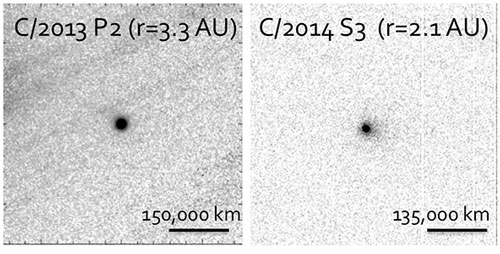 Astronomers are announcing today the discovery of two unusual objects in comet-like orbits that originate in the Oort cloud but with almost no activity, giving scientists a first look at their surfaces. These results are particularly intriguing because the surfaces are different from what astronomers expected.
Astronomers are announcing today the discovery of two unusual objects in comet-like orbits that originate in the Oort cloud but with almost no activity, giving scientists a first look at their surfaces. These results are particularly intriguing because the surfaces are different from what astronomers expected.
Nov 11th, 2014
Read more
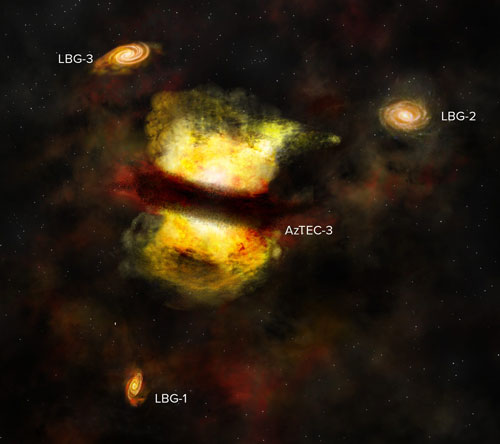 Nestled among a triplet of young galaxies more than 12.5 billion light-years away is a cosmic powerhouse: a galaxy that is producing stars nearly 1,000 times faster than our own Milky Way. This energetic starburst galaxy, known as AzTEC-3, together with its gang of calmer galaxies may represent the best evidence yet that large galaxies grow from the merger of smaller ones in the early Universe, a process known as hierarchical merging.
Nestled among a triplet of young galaxies more than 12.5 billion light-years away is a cosmic powerhouse: a galaxy that is producing stars nearly 1,000 times faster than our own Milky Way. This energetic starburst galaxy, known as AzTEC-3, together with its gang of calmer galaxies may represent the best evidence yet that large galaxies grow from the merger of smaller ones in the early Universe, a process known as hierarchical merging.
Nov 11th, 2014
Read more
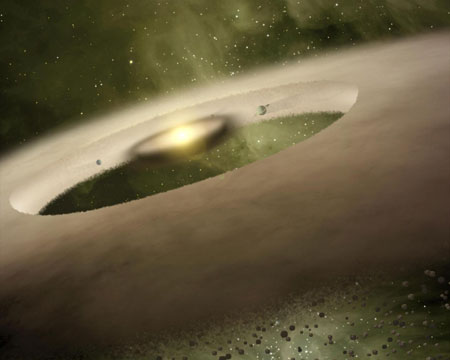 Astronomers have discovered two dust belts surrounded by a large dust halo around young star HD 95086. The findings provide a look back at what our solar system may have resembled in its infancy.
Astronomers have discovered two dust belts surrounded by a large dust halo around young star HD 95086. The findings provide a look back at what our solar system may have resembled in its infancy.
Nov 10th, 2014
Read more
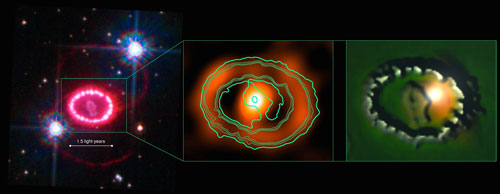 Observations with the ATCA and ALMA radio telescopes have shown signs of something never seen before, located at the center or the remnant of a supernova. It could be a pulsar wind nebula, driven by the spinning neutron star, or pulsar, which astronomers have been searching for since 1987.
Observations with the ATCA and ALMA radio telescopes have shown signs of something never seen before, located at the center or the remnant of a supernova. It could be a pulsar wind nebula, driven by the spinning neutron star, or pulsar, which astronomers have been searching for since 1987.
Nov 10th, 2014
Read more
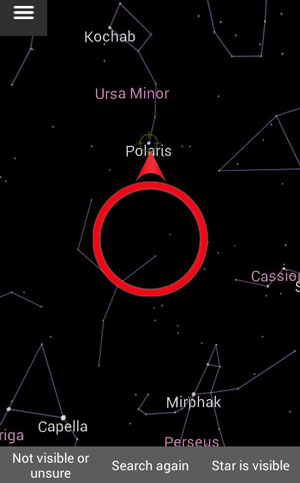 Light pollution is not only a problem for astronomy. Scientists from the interdisciplinary project 'Loss of the Night' study how it affects health, society, and the environment. In order to measure how skyglow is changing, they have developed an app for smartphones, which allows citizen scientists to count the number of visible stars in the night sky.
Light pollution is not only a problem for astronomy. Scientists from the interdisciplinary project 'Loss of the Night' study how it affects health, society, and the environment. In order to measure how skyglow is changing, they have developed an app for smartphones, which allows citizen scientists to count the number of visible stars in the night sky.
Nov 10th, 2014
Read more
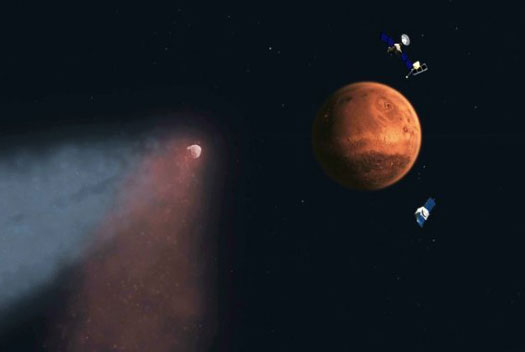 Two NASA and one European spacecraft have gathered new information about the basic properties of a wayward comet that buzzed by Mars Oct. 19, directly detecting its effects on the Martian atmosphere.
Two NASA and one European spacecraft have gathered new information about the basic properties of a wayward comet that buzzed by Mars Oct. 19, directly detecting its effects on the Martian atmosphere.
Nov 7th, 2014
Read more
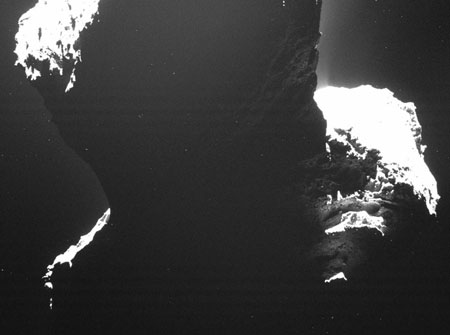 Light scattered from dust particles allows a first glance at the side of comet 67P that has been trapped in the darkness of polar night for the last months.
Light scattered from dust particles allows a first glance at the side of comet 67P that has been trapped in the darkness of polar night for the last months.
Nov 7th, 2014
Read more
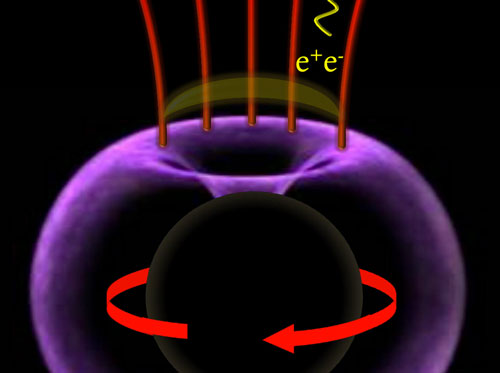 MAGIC telescopes observe an extremely short, powerful outburst of radiation in Galaxy IC 310.
MAGIC telescopes observe an extremely short, powerful outburst of radiation in Galaxy IC 310.
Nov 7th, 2014
Read more
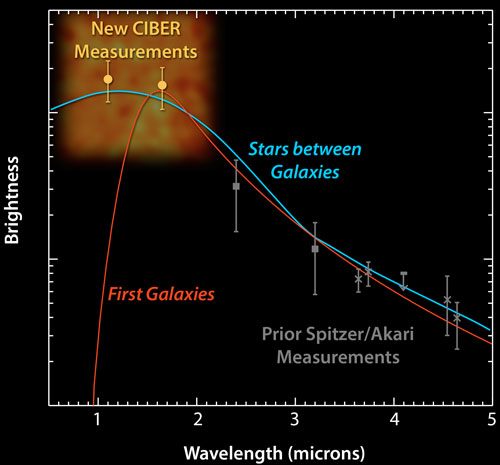 A sounding rocket experiment has detected a surprising surplus of infrared light in the dark space between galaxies, a diffuse cosmic glow as bright as all known galaxies combined. The glow is thought to be from orphaned stars flung out of galaxies.
A sounding rocket experiment has detected a surprising surplus of infrared light in the dark space between galaxies, a diffuse cosmic glow as bright as all known galaxies combined. The glow is thought to be from orphaned stars flung out of galaxies.
Nov 7th, 2014
Read more
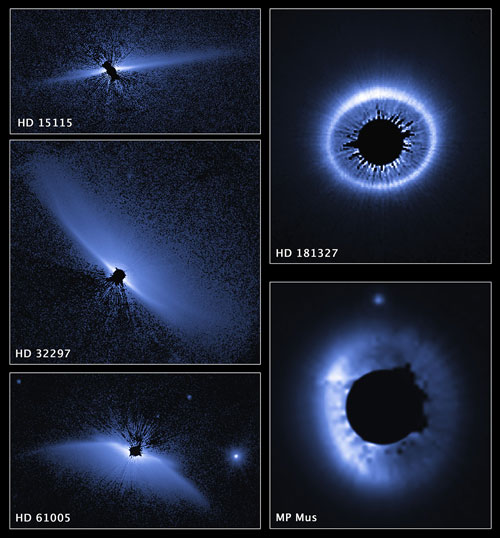 Astronomers using the Hubble Space Telescope have completed the largest and most sensitive visible-light imaging survey of dusty debris disks around other stars. These dusty disks, likely created by collisions between leftover objects from planet formation, were imaged around stars as young as 10 million years old and as mature as more than 1 billion years old.
Astronomers using the Hubble Space Telescope have completed the largest and most sensitive visible-light imaging survey of dusty debris disks around other stars. These dusty disks, likely created by collisions between leftover objects from planet formation, were imaged around stars as young as 10 million years old and as mature as more than 1 billion years old.
Nov 6th, 2014
Read more
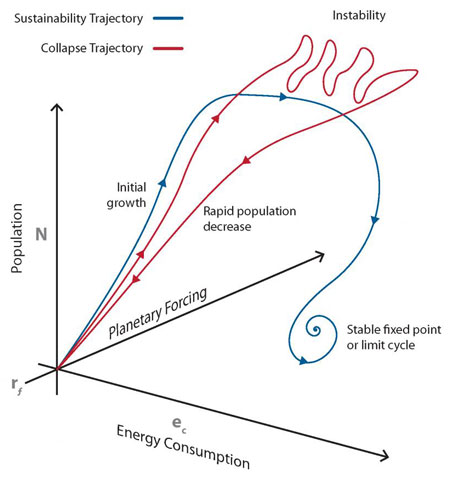 Two astrophysicists argue that questions about the future of life on Earth and beyond may soon be resolvable scientifically, thanks to new data about the Earth and about other planets in our galaxy, and by combining the earth-based science of sustainability with the space-oriented field of astrobiology.
Two astrophysicists argue that questions about the future of life on Earth and beyond may soon be resolvable scientifically, thanks to new data about the Earth and about other planets in our galaxy, and by combining the earth-based science of sustainability with the space-oriented field of astrobiology.
Nov 6th, 2014
Read more
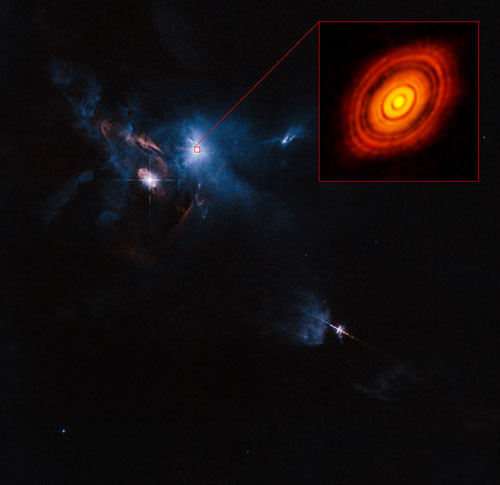 For ALMA's first observations in its new and most powerful mode, researchers pointed the antennas at HL Tauri - a young star, about 450 light-years away, which is surrounded by a dusty disc. The resulting image exceeds all expectations and reveals unexpectedly fine detail in the disc of material left over from star birth.
For ALMA's first observations in its new and most powerful mode, researchers pointed the antennas at HL Tauri - a young star, about 450 light-years away, which is surrounded by a dusty disc. The resulting image exceeds all expectations and reveals unexpectedly fine detail in the disc of material left over from star birth.
Nov 6th, 2014
Read more
Instead of WIMPS or axions, dark matter may be made of macroscopic objects as small as a few ounces up to the size of a good asteroid, and probably as dense as a neutron star or the nucleus of an atom.
Nov 4th, 2014
Read more
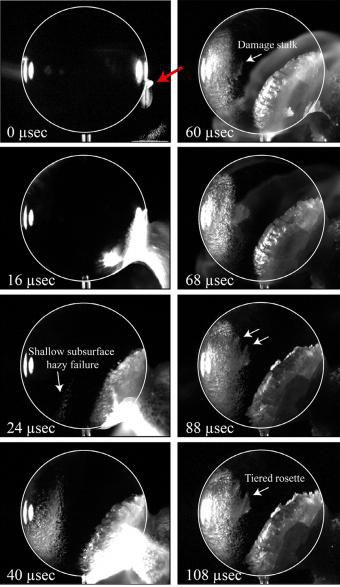 Collisions of heavenly bodies generate almost unimaginable levels of energy. Researchers at Brown University used NASA's ultra-high-speed cannon and computer models to simulate such a collision on Vesta, the second-largest object in the asteroid belt. Their analysis of the images - taken at a million frames per second - shows how Vesta may have gotten the deep grooves that encircle its midsection.
Collisions of heavenly bodies generate almost unimaginable levels of energy. Researchers at Brown University used NASA's ultra-high-speed cannon and computer models to simulate such a collision on Vesta, the second-largest object in the asteroid belt. Their analysis of the images - taken at a million frames per second - shows how Vesta may have gotten the deep grooves that encircle its midsection.
Nov 4th, 2014
Read more
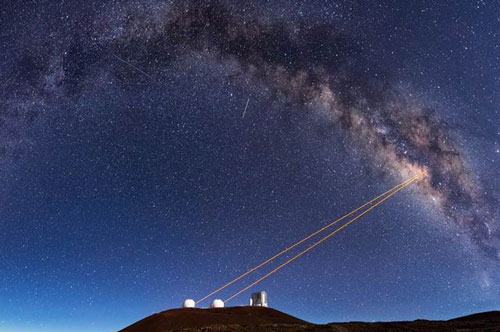 The mystery about a thin, bizarre object in the center of the Milky Way that some astronomers believe to be a hydrogen gas cloud headed toward our galaxy's enormous black hole has been solved by UCLA astronomers.
The mystery about a thin, bizarre object in the center of the Milky Way that some astronomers believe to be a hydrogen gas cloud headed toward our galaxy's enormous black hole has been solved by UCLA astronomers.
Nov 4th, 2014
Read more
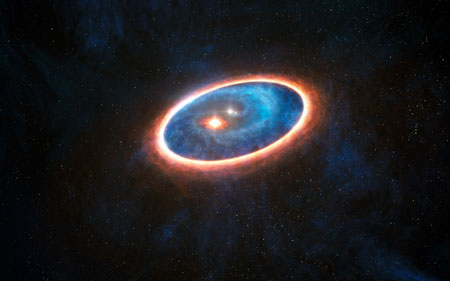 An international team of astronomers has carried out the most accurate study so far of the cocoon of gas and dust surrounding the GG Tau A system. By combining complementary observations at submillimeter (ALMA and IRAM) wavelengths with those at infrared (VLTI/ESO) wavelengths, the researchers were able to identify the complex dynamics at work in GG Tau.
An international team of astronomers has carried out the most accurate study so far of the cocoon of gas and dust surrounding the GG Tau A system. By combining complementary observations at submillimeter (ALMA and IRAM) wavelengths with those at infrared (VLTI/ESO) wavelengths, the researchers were able to identify the complex dynamics at work in GG Tau.
Nov 3rd, 2014
Read more
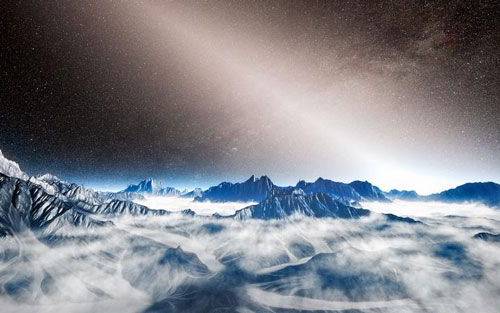 A team of astronomers observed 92 nearby stars to probe exozodiacal light from hot dust close to their habitable zones and combined the new data with earlier observations.
A team of astronomers observed 92 nearby stars to probe exozodiacal light from hot dust close to their habitable zones and combined the new data with earlier observations.
Nov 3rd, 2014
Read more
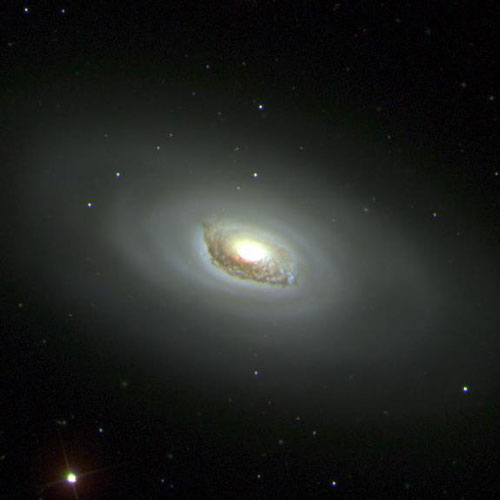 New research offers a novel insight into the nature of dark matter and dark energy and what the future of our Universe might be.
New research offers a novel insight into the nature of dark matter and dark energy and what the future of our Universe might be.
Oct 31st, 2014
Read more
 Astronomers are announcing today the discovery of two unusual objects in comet-like orbits that originate in the Oort cloud but with almost no activity, giving scientists a first look at their surfaces. These results are particularly intriguing because the surfaces are different from what astronomers expected.
Astronomers are announcing today the discovery of two unusual objects in comet-like orbits that originate in the Oort cloud but with almost no activity, giving scientists a first look at their surfaces. These results are particularly intriguing because the surfaces are different from what astronomers expected.
 Subscribe to our Space Exploration News feed
Subscribe to our Space Exploration News feed














